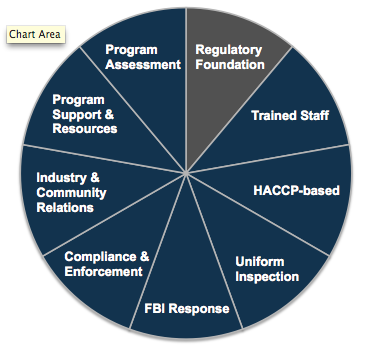Framework for the Food Code
Adoption of the FDA Food Code (Code) at the state, local and tribal level has been an essential component in the effort to promote greater consistency of food safety practices. However, it was clear that regulatory programs that administer the Food Code would also require a set of widely recognized standards. To meet this need FDA has developed, with broad stakeholder input, the "Voluntary National Retail Food Regulatory Program Standards" (Program Standards) to identify what constitutes a highly effective and responsive retail food regulatory program.
Regulatory Foundation is only one part of a comprehensive retail food protection program. The pie chart below depicts the eight additional components of "FDA's Recommended Retail Food Regulatory Program Standards."

Key Interventions
The Code incorporates five key public health interventions to protect the consumer from foodborne illness which were introduced with the 1993 Code. Not surprisingly, they have been debated. Below are the five interventions.
Demonstration of Knowledge (2-102.11)
During inspections or upon request, the manager or person-in-charge (PIC) should be able to demonstrate knowledge of foodborne disease prevention, Hazard Analysis Critical Control Points principles, and the requirements of the Code. This includes complying with the Code, being a certified food protection manager, and being able to respond correctly to the inspector's questions as they relate to specific food operations.
Areas of knowledge include understanding the following:
- relationship between the prevention of foodborne disease and the personal hygiene of a food employee
- the responsibility of a person in charge for preventing the transmission of foodborne disease by a sick employee
- symptoms associated with foodborne illness
- significance of maintaining the time and temperature of potentially hazardous food in preventing foodborne illness
- hazards involved in the consumption of raw or undercooked meat, poultry, eggs, and fish
- required food temperatures and times for safe cooking of potentially hazardous food
- required temperatures and times for the safe refrigerated storage, hot holding, cooling, and reheating of potentially hazardous food
Employee Health (2-201)
It is the responsibility of the person in charge (PIC) to require reporting by food employees information about their health and activities that may relate to the transmission of foodborne disease. Information should be reported in a manner that the PIC can prevent the transmission of foodborne disease, including the date of onset of jaundice or certain illnesses such as E. coli O157:H7, Shigella spp., Salmonella Typhi, and Hepatitis A.
Time/Temperature (3-401.11)
Raw animal foods including eggs, fish, meat, and poultry should be cooked in such a way as to heat all parts of the food to a given temperature for a given time, which will vary depending on the type of food being cooked. Examples of specific temperatures and times include:
 |
Turn the pages by clicking on the right of each page to view examples of specific temperatures and times. |
|
This content requires JavaScript enabled.
|
|
Hands as a Vehicle of Contamination (3-301.11)
Procedure should be in place to limit hand contact as a potential vehicle of contamination. Food employees should wash their hands using proper technique, which is specified in §2-301.12. Food employees are not to handle exposed, ready-to-eat food with their bare hands, and should use utensils such as deli tissue, spatulas, tongs, single-use gloves, or dispensing equipment. Bare hand and arm contact with exposed food that is NOT in ready-to-eat form should be minimized.
Please refer to subpart 2-301 to answer the following questions.
Consumer Advisory (3-603.11)
This section is designed to provide the options available to food establishments when advising consumers of the inreased risk of foodborne illness upon consumption of raw or undercooked foods that are animal-derived. The image below illustrates the consumer advisory notice found on food menus.

Two major components to satisfactory compliance include disclosure and reminder.
Disclosure
- food establishment describes items, such as:
- oysters on the half-shell (raw oysters),
- raw-egg Caesar salad, and
- hamburgers (can be cooked to order)
- Another method for disclosure is when items are asterisked to a footnote stating that the items are:
- served raw or undercooked, or
- contain (or may contain) raw or undercooked ingredients
Reminder
- items that require disclosure are asterisked to a footnote stating:
- regarding the safety of these items, written information is available upon request
- consuming raw or undercooked meats, poultry, seafood, shellfish, or eggs may increase your risk of foodborne illness, or
- consuming raw or undercooked meats, poultry, seafood, shellfish, or eggs may increase your risk of foodborne illness, especially if you have certain medical conditions
Foodborne Illness Risk Factors
The Code also incorporates in its provisions the means to control the risk factors most frequently identified by the Centers for Disease Control as contributing factors in reported foodborne illness outbreaks.
 |
Roll over the tabs to view more information. |
|
This content requires JavaScript enabled.
|
|




